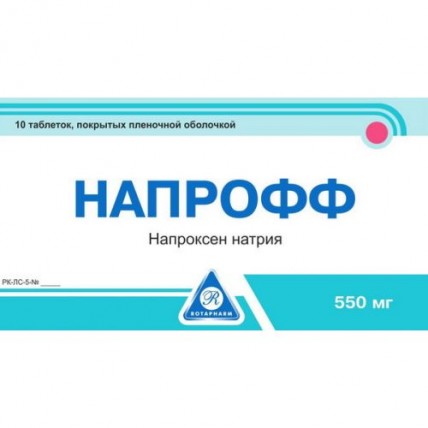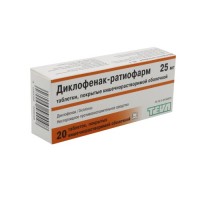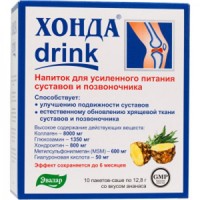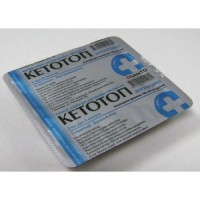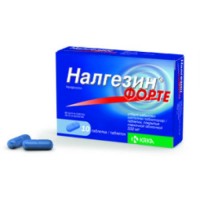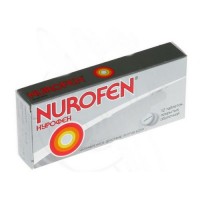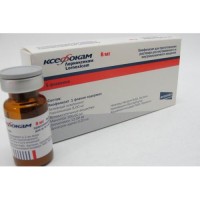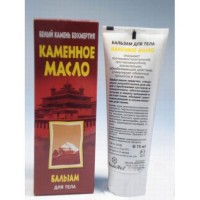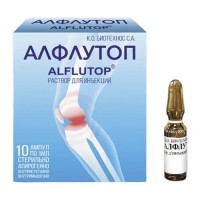Naproff 10s 550 mg film-coated tablets
- $8.40
The instruction for medical use of NAPROFF medicine the Trade name Naproff Mezhdunarodnoye the unlicensed name Naproxenum Dosage Form of the Tablet, film coated 550 mg Structure One tablet contains active agent - Naproxenum of sodium of 550 mg, excipients: cellulose microcrystalline rn 101, K30 povidone, talc, magnesium stearate, water purified. structure of a cover: opadray Belyy® (Y-1-7000), methylene dichloride, ethanol. structure of Opadri® of white (Y-1-7000), as a percentage GPMC 2910/Gipromelloza 5 sr, titan dioxide (E171), propylene glycol. The description of the Tablet, film coated white color, oval, biconvex with dividing risky on both sides. Pharmacotherapeutic group Anti-inflammatory and antirheumatic drugs. Non-steroidal anti-inflammatory drugs. Propionic acid derivatives. Naproxenum. ATH M01AE02 code the Pharmacological Pharmacokinetics Later properties of intake Naproxenum of sodium is quickly and almost completely absorbed from digestive tract. The bioavailability is 95%. Elimination half-life of Naproxenum makes 12-17 hours. Meal does not affect concentration of Naproxenum in blood. The maximum concentration of Naproxenum of sodium in blood is reached in 1-2 hours. The volume of distribution is 0.16 l/kg. At reception in therapeutic concentration of 99% of active agent contacts proteins. Naproxenum is metabolized in a liver to 6-O-desmetilnaproksena. Then and Naproxenum, and 6-O-desmetilnaproksen enter conjugation tests. The clearance of Naproxenum is 0.13 ml/min. About 95% of Naproxenum are allocated with urine in the form of invariable Naproxenum, 6-O-desmetilnaproksena and their conjugates. The pharmacodynamics Naproff is non-steroidal anti-inflammatory drug. Renders the significant anti-inflammatory, analgeziruyushchy and febrifugal action. The mechanism of action of Naproff consists in slowing down of migration of leukocytes, decrease of the activity of lysosomes and mediators of inflammation. Drug is lipoxygenase inhibitor, blocks synthesis of arachidonic acid. Besides, brakes activity of TsOG-1 and TsOG-2 of arachidonic acid that leads to oppression of synthesis of intermediate products of prostaglandins. Slows down aggregation of thrombocytes. Naproxenum of sodium is not narcotic analgetic and does not influence the central nervous system. Indications the Drug Naproff is shown to use for treatment: - a pseudorheumatism - an osteoarthritis (degenerative arthritis) - an ankylosing spondylitis - acute gout - acute skeletal and muscular disorders - dysmenorrheas - a juvenile pseudorheumatism at children are more senior than 5 years the Route of administration and doses Naproff accept inside, it is preferable in time or after a meal. Adult Pseudorheumatism, osteoarthritis and ankylosing spondylitis: 550 mg-1100 of mg a day in two steps at an interval of 12 hours or in need of a daily dose of 1100 mg are possible use of two doses on 550 mg in two steps or in one step. The size of a morning and evening dose can be corrected on the basis of the dominating symptoms (i.e. night pain or morning constraint). Acute gout: an initial dose - 825 mg, then on 275 mg each 8 hours before the termination of an attack. Acute skeletal and muscular disorders and dysmenorrhea: an initial dose - 550 mg, then on 275 mg each 6-8 hours according to need to the maximum dose of 1375 mg a day after the first day. A load dose Single dose of two tablets in the morning or in the evening as a load dose of 825 mg-1100 of mg a day in a sharp phase of a disease is recommended in the following cases: a) for patients with severe night pain and/or morning constraint, b) for the patients beginning treatment with Naproxenum upon transition from therapy by high doses of other antirheumatic drug, c) in an osteoarthritis with pain as the dominating symptom. Children In a juvenile pseudorheumatism at children are more senior than 5 years the dosage of 10 mg/kg a day in two steps at an interval of 12 hours is applied. Elderly patients Elderly patients are exposed to the increased risk of emergence of serious undesirable reactions. In need of use of non-steroidal anti-inflammatory drugs (NPVS) it is necessary to accept minimal effective doses during the shortest possible span. During treatment of NPVS it is necessary to carry out regular control of patients on presence of gastrointestinal bleeding. Researches show that, despite invariable general concentration of Naproxenum in blood plasma, the fraction of untied Naproxenum in plasma at elderly patients raises. The importance of this fact for dosing of Naproxenum is unknown. As well as at treatment by other drugs, at elderly patients it is necessary to apply minimal effective doses. At elderly patients with a renal failure it is necessary to reduce a dosage. Undesirable effects can be minimized by use of minimal effective doses during the shortest possible span necessary for achievement of effect. A renal / liver failure low doses of drug are recommended to Patients with a renal or liver failure. Naproff is contraindicated to patients with basic indicators of clearance of creatinine less than 30 ml/min. as at patients with a heavy renal failure or at the patients subject to dialysis, accumulation of metabolites of Naproxenum was traced. Duration of treatment and carrying out repeated courses depend on character and disease severity and is defined by the attending physician. Side effects the Used lower than the parameters of frequency of undesirable reactions are defined as follows: often (≥ 1/100, but & lt, 1/10), infrequently (≥ 1/1000, but & lt, 1/100), it is rare (≥ 1/10000, but & lt, 1/1000), is very rare (& lt, 1/10000), frequency is unknown (frequency cannot be established because of insufficiency of data). From blood and lymphatic system: seldom - hemolytic anemia, it is very rare – the granulocytopenia, thrombocytopenia, an agranulocytosis, frequency is unknown - aplastic anemia, a neutropenia. From the immune system: seldom - allergic reactions and reactions of hypersensitivity, an anaphylaxis. From metabolism and food: seldom - a hyperpotassemia. Disturbances of mentality: infrequently - the depression, disturbance of cognitive function, insomnia, concentration loss, abnormal dreams, frequency is unknown - hallucinations. From nervous system: often - confusion of consciousness, dizziness, drowsiness, a headache, it is very rare - spasms, aseptic meningitis (especially at patients with the existing autoimmune disorders, such as system lupus erythematosus, the mixed disease of connective tissue with the following symptoms: the constraint of cervical muscles, a headache, nausea, vomiting, fever and a disorientation), frequency is unknown - vertigo, paresthesias, an indisposition, exacerbation of Parkinson's disease. From an organ of sight: often - a disorder of vision, frequency it is unknown - an optic neuritis, a papilledema. From an organ of hearing and balance: often - sonitus, it is rare - a hearing disorder. From heart: infrequently - a cardiopalmus, frequency it is unknown - heart failure. From vessels: seldom - a vasculitis, it is very rare - the arterial trombotichesky phenomena, for example, a myocardial infarction or a stroke, frequency is unknown - hypertensia. From respiratory organs, a thorax and mediastinum: seldom - the complicated asthma, eozinofilichesky pneumonia, frequency is unknown - a bronchospasm, an asthma, rhinitis, a fluid lungs. From digestive tract: very seldom - pancreatitis, frequency it is unknown - thirst, round ulcers, gastrointestinal perforation or bleeding (sometimes with a lethal outcome, in particular, at elderly patients), nausea, vomiting, diarrhea, a meteorism, a constipation, dyspepsia, an abdominal pain, a melena, a hematemesis, a stomacace, exacerbation of colitis and Crohn's disease, gastritis. From a liver and biliary tract: seldom - hepatitis (sometimes with a lethal outcome), jaundice, frequency is unknown - an abnormal liver function. From skin and hypodermic fabric: often - rash, an itching, a purpura, infrequently - a small tortoiseshell, photosensitivity, it is rare - an alopecia, a pseudo-porphyria, is very rare - a mnogoformny erythema, Stephens-Johnson's syndrome, a toxic epidermal necrolysis, a bullous epidermolysis, frequency is unknown - a Quincke's disease, epidermal necrosis, an exfoliative and bullous dermatosis, red flat deprive. From skeletal and muscular and connective tissue: seldom - myalgia, muscle weakness. From kidneys and urinary tract: very seldom - glomerular nephrite, a hamaturia, interstitial nephrite, a nephritic syndrome, papillary necrosis of kidneys, frequency it is unknown - a renal failure, a nephropathy, increase in levels of creatinine in blood serum. From a reproductive system and a mammary gland: frequency is unknown - disturbance of fertility at women. The general disorders and disturbances in the injection site: often – exhaustion, frequency it is unknown - weak peripheral hypostasis, heat. Results of clinical and epidemiological trials show that use of some NPVS (especially in high doses and at long-term treatment) can cause increase in risk of emergence of the arterial trombotichesky phenomena (for example, a myocardial infarction or a stroke. Contraindications - hypersensitivity to Naproxenum of sodium or any of excipients - to patients with active gastrointestinal bleeding or a peptic ulcer - the acute or available in the anamnesis recurrent round ulcer / bleeding (two or more cases of the confirmed ulcer or bleeding), - asthma, rhinitis, an angiodystrophia or urticaria other allergic reactions coherent with reception of an ibuprofen, acetylsalicylic acid or other NPVS - a heavy heart and renal failure (clearance of creatinine & lt, 30 mg/min.) - the profound liver failure or a disease of a liver in an aggravation stage - existence in the anamnesis of gastrointestinal bleeding or perforation, connected with the previous use of NPVS, - the third trimester of pregnancy - children's age up to 5 years Medicinal interactions Naproxenum highly contacts proteins therefore the patients accepting hydantoins, anticoagulants or sulfonamides with high extent of linking with proteins have to be observed regarding identification of signs of overdose of drugs. In clinical trials interactions with Naproxenum or drugs of sulphonylurea were not observed, however it is necessary to be careful as interaction at use of other nonsteroid drugs of this class was noted. Lithium: it was reported that NPVS, including Naproxenum, increase equilibrium levels of lithium in blood plasma by inhibition of renal clearance of lithium. Removal of lithium decreases. It is recommended to control lithium levels at the beginning of use, correction of a dose or cancellation of Naproxenum. Antihypertensive drugs: the antihypertensive effect decreases. Simultaneous use of Naproxenum with beta-blockers can weaken their antihypertensive effect and increase risk of the renal failure connected with intake of APF inhibitors or antagonists of angiotensin II. At the same time applied probenetsid increases Naproxenum levels in blood plasma and considerably increases its elimination half-life. It is necessary to be careful at a concomitant use of a methotrexate as strengthening of its toxicity as Naproxenum, as well as other NPVS, reduced canalicular secretion of a methotrexate in animal models is possible. The natriuretic effect of furosemide was inhibited by drugs of this class. NPVS can aggravate heart failure, reduce glomerular filtration rate and increase levels of cardiac glycosides in blood plasma at their simultaneous use. As well as at use of all NPVS, it is necessary to be careful at a concomitant use of cyclosporine because of increase in risk of nephrotoxicity. It is not necessary to apply NPVS within 8-12 days after intake of mifepristone as NPVS can weaken its effects. As well as at use of all NPVS, it is necessary to be careful at simultaneous use of corticosteroids because of increase in risk of developing of gastrointestinal ulcers or bleeding. Other analgetics, including selection inhibitors of cyclooxygenase-2: it is necessary to avoid simultaneous use of two or more NPVS (including aspirin) as it can increase risk of emergence of adverse effects. Diuretics: NPVS can reduce effect of diuretics and antihypertensive medicines. Risk of developing an acute renal failure, usually reversible, can increase at some patients with a renal failure (for example, patients with dehydration or elderly patients) at simultaneous use of antagonists of receptors of angiotensin II with NPVS. Therefore it is necessary to apply similar combinations to care, especially at elderly patients. It is necessary to provide sufficient water consumption by patients and to carry out control of function of kidneys after the beginning of the combined treatment and periodically during treatment. Diuretics can increase risk of development of nephrotoxicity of NPVS. Anticoagulants: NPVS can enhance effects of anticoagulants, such as warfarin. Hinolonovy antibiotics: results of tests on animals show that NPVS are capable to increase risk of developing of the spasms caused by hinolonovy antibiotics. The patients accepting NPVS and hinolona can be exposed to the increased risk of developing spasms. Antithrombocytic drugs and selective serotonin reuptake inhibitors (SSRI): the risk of gastrointestinal bleeding increases. Takrolimus: increase in risk of emergence of nephrotoxicity at use of NPVS together with takrolimusy is possible. Zidovudine: the risk of hematologic toxicity at use of NPVS with a zidovudine increases. HIV have evidence of increase in risk of developing of a hemarthrosis and hematomas (+) the patients with hemophilia who are exposed to simultaneous treatment by a zidovudine and an ibuprofen. Bisfosfonata: simultaneous use of bisfosfonat and NPVS can increase risk of damage of a mucous membrane of a stomach. Colestyraminum: Colestyraminum we slow down Naproxenum absorption. It is necessary to accept Naproxenum not less than in one hour prior to or in 4-6 hours after intake of Colestyraminum. Special instructions Undesirable effects can be minimized by use of minimal effective doses during the shortest span necessary for control of symptoms. Cardiovascular and cerebrovascular effects Observation is required to patients with presence of hypertensia and/or weak or moderate stagnant heart failure in the anamnesis as it was reported about a delay of liquid and hypostasis from communication with use of NPVS. Results of clinical and epidemiological trials show that use of Naproxenum and some NPVS (in particular, at high doses and big duration of treatment) can be connected with small increase in risk of emergence of the arterial trombotichesky phenomena (for example, a myocardial infarction or a stroke). In spite of the fact that Naproxenum use (1000 mg a day), according to these results, can represent smaller risk, existence of some degree of risk cannot be excluded. Patients with uncontrollable hypertensia, the stagnant heart failure established by coronary heart disease, a disease of peripheral arteries and/or a cerebrovascular disease it is necessary to accept Naproxenum only after careful individual assessment of a ratio of advantage and risk. The same way, it is necessary to carry out the assessment at the beginning of long-term treatment of patients with risk factors of developing of cardiovascular diseases (for example, hypertensia, a lipidemia, diabetes, smoking). Bleeding, ulceration and perforation of digestive tract Gastrointestinal bleeding, an ulceration or perforation which can have a lethal outcome were observed at use of all NPVS, at any moment of treatment, at existence or lack of the warning symptoms or serious gastrointestinal phenomena in the anamnesis. The risk of developing of gastrointestinal bleeding, an ulceration or perforation is higher: - at increase in doses of NPVS, - at patients with the ulcer which is especially complicated by bleeding or perforation in the anamnesis, - at elderly patients, -
at simultaneous alcohol intake, - when smoking. Treatment of such patients needs to be begun with the minimum possible dose. It is necessary to consider the possibility of therapy in combination with preventive drugs (for example, mizoprostoly or inhibitors of the proton pump) at such patients and also at patients who need use of low doses of aspirin or other drugs increasing risk concerning digestive tract. Patients with gastrointestinal diseases in the anamnesis including elderly, have to report about all unusual symptoms from abdominal organs (in particular gastrointestinal bleeding), since the initial stages of treatment. It is necessary to be careful at the patients who are at the same time taking the drugs capable to increase risk of developing of an ulcer or bleeding, such as oral corticosteroids, anticoagulants (warfarin), selective serotonin reuptake inhibitors or antithrombocytic drugs, such as aspirin. When developing gastrointestinal bleeding or ulcer at the patients accepting Naproxenum it is necessary to stop treatment. It is necessary to be careful when assigning NPVS to patients with digestive tract diseases (ulcer colitis, Crohn's disease) in the anamnesis as at them exacerbation of a disease is possible. Dysfunctions of a cardiovascular system, kidneys and a liver Use of NPVS can cause dose-dependent decrease in formation of prostaglandins and provoke a renal failure. To the greatest risk of emergence of similar reaction patients with a renal failure, hearts are exposed, to a liver and also the patients accepting diuretics and elderly patients. At such patients it is necessary to carry out control of function of kidneys. A renal failure It is necessary to apply Naproxenum carefully at patients with a renal failure as substance to a large extent (95%) is removed by glomerular filtration, at such patients the control of levels of creatinine in serum of blood and/or clearance of creatinine has to be exercised. Naproxenum is not recommended to patients with initial clearance of creatinine lower than 20 ml/min. Some patients in particular having disturbances of a renal blood-groove because of exhaustion of extracellular volume, cirrhosis, restriction of consumption of sodium, stagnant heart failure and the existing disease of a liver need assessment of function of kidneys to and during treatment by Naproxenum. Some elderly patients at whom the renal failure can be expected and also the patients accepting diuretics can also get to this category. It is necessary to consider the possibility of decrease in a daily dose in order to avoid probable excessive accumulation of metabolites of Naproxenum at such patients. An abnormal liver function the Chronic alcoholic disease of a liver and probably other forms of cirrhosis reduce the general concentration of Naproxenum in blood plasma, however concentration of untied Naproxenum in plasma increases. Importance of this fact for dosing of Naproxenum is unknown, however it is reasonable to apply a minimal effective dose. It is necessary to be careful at use of drug for patients with an abnormal liver function or the instruction on it in the anamnesis. Elderly patients the Frequency of emergence of adverse reactions to NPVS, especially gastrointestinal bleeding which can have a lethal outcome at elderly patients increases. Disturbances of breath It is necessary to be careful at use of drug for patients with bronchial asthma or the instruction on it in the anamnesis as it was reported about provoking of a bronchospasm under the influence of NPVS at such patients. The hard currency and the mixed disease of connective tissue At patients with the system lupus erythematosus (SLE) and the mixed diseases of connective tissue can raise risk of developing aseptic meningitis. The dermatological phenomena At use of NPVS it was seldom reported about serious skin reactions, sometimes with a lethal outcome, including exfoliative dermatitis, Stephens-Johnson's syndrome and a toxic epidermal necrolysis. Patients are exposed to the greatest risk of emergence of similar reactions at early stages of treatment: the beginning of reaction in most cases falls on the first month of treatment. It is necessary to stop use of Naproxenum at the first symptoms of skin rash, damages of mucous membranes or other signs of hypersensitivity. Disturbance of fertility at women Use of Naproxenum can break fertility at women and it is not recommended to the women planning pregnancy. At the women who are experiencing difficulties with conception or passing a fertility research it is necessary to consider the possibility of cancellation of Naproxenum. Anaphylactic (anaphylactoid) reactions At sensitive patients can arise reactions of hypersensitivity. Anaphylactic (anaphylactoid) reactions can be shown at patients both with existence, and with lack of hypersensitivity to aspirin, other non-steroidal anti-inflammatory drugs or Naproxenum - to the containing drugs in the anamnesis. Similar reactions can also arise at patients with a Quincke's disease, spastic reaction of bronchial tubes (for example, asthma), rhinitis and polyps in a nose in the anamnesis. Anaphylactoid reactions, such as anaphylaxis, can have a lethal outcome. Naproxenum, as well as other NPVS, reduces aggregation of thrombocytes and increases a bleeding time. It is necessary to consider this effect when determining a bleeding time. Patients with disturbances of coagulation or the taking drugs influencing a hemostasis have to be exposed to careful observation during treatment by Naproxenum. Patients on full anticoagulating therapy (for example, heparin or warfarin) can have the increased risk of bleeding at simultaneous use of Naproxenum. In that case assessment of advantage and risks is required. At some patients accepting Naproxenum the weak peripheral hypostasis was observed. Despite the absence of messages about a sodium delay in metabolism researches, increase in risk at use of Naproxenum for patients with the suspect or the established disturbance of this function is possible. Steroids If necessary to reduce a dosage of steroids or to cancel them during treatment by Naproxenum, it is necessary to carry out decrease slowly and at careful control of patients on presence of adverse effects, including insufficiency of bark of adrenal glands and aggravation of symptoms of arthritis. Effects concerning eyes of the Research did not reveal the changes connected using Naproxenum from eyes. It was in rare instances reported about emergence of disturbances, including a papillitis, a retrobulbar optic neuritis and a papilledema, at the patients applying NPVS including Naproxenum. Thus, patients who have disorders of vision during treatment Naproxenum - the containing drugs have to have ophthalmologic examination. A combination with other NPVS Use of a combination Naproxenum - the containing drugs and other NPVS are not recommended because of overall risk of induction of the serious adverse effects connected with reception of NPVS. It is necessary to avoid use of Naproxenum along with NPVS, including selection inhibitors of cyclooxygenase-2. Febrifugal and anti-inflammatory effect of Naproxenum can reduce body temperature and weaken inflammation, reducing the acceptability of these parameters as diagnostic characters. Interference with laboratory indicators the Treatment by Naproxenum should be interrupted not less than in 48 hours before carrying out analyses of function of bark of adrenal glands as drug can affect results of some analyses of 17-ketonogenny steroids. The same way Naproxenum can influence some analyses for determination of levels of 5-hydroxyindolacetic acid in urine. Separate disturbances of results of laboratory analyses were noted (for example, functional hepatic tests) at the patients who are exposed to treatment by Naproxenum, however it was not established to a certain trend concerning any analysis indicating toxicity. The headache as a result of abuse of medicines After prolonged use of analgetic means can arise or amplify a headache. It is necessary to suspect a headache as a result of abuse of medicines at patients with the frequent or daily headache arising contrary to regular use of analgetics (or because of it). Patients with a headache as a result of abuse of medicines should not raise a dosage. In such cases it is necessary to see a doctor and to cancel analgetic drugs. Use in pediatrics Naproff is applied at children aged 5 years for treatment of juvenile arthritis in a daily dose of 10 mg/kg of body weight at an interval of 12 hours are more senior. Use at pregnancy and a lactation Pregnancy Inhibition of synthesis of prostaglandins can have negative effect on pregnancy and/or embriofetalny development. Results of epidemiological researches indicate increase in risk of a miscarriage of pregnancy and heart disease after use of inhibitor of synthesis of prostaglandins in the early stages of pregnancy. The absolute risk of emergence of defects of a cardiovascular system increased from less than 1% to about 1.5%. It is supposed that this risk increases parallel to a dose and duration of therapy. Use of inhibitors of synthesis of prostaglandins for animals led to increase pre- and post-implantation losses and embriofetalny mortality. Besides, it was reported about increase in frequency of developing of various malformations, including defects of a cardiovascular system, at the animals receiving inhibitors of synthesis of prostaglandins in the period of an organogenesis. In the first and second trimesters of pregnancy it is necessary to use the drug Naproff only at urgent need. If Naproff is applied by the woman trying to become pregnant or in the first or second trimesters of pregnancy, the dose has to be minimum, and treatment duration – the shortest. In the first trimester of pregnancy all inhibitors of synthesis of prostaglandins can put a fruit at risk: - cardiopulmonary toxicity (with premature closing of an arterial channel and pulmonary hypertensia), - the renal failure capable to progress to a renal failure with oligogidramniony, mother and the newborn child, at the end of pregnancy, to risk: - possible increase in a bleeding time that is manifestation of antiagregantny effect which can arise even at very low doses, - the suppression of reductions of a uterus leading to delay or extension of childbirth. Therefore, the drug Naproff is contraindicated in the last trimester of pregnancy. A lactation In the limited researches conducted so far it was established that NPVS can get into breast milk in very low concentration. Whenever possible it is necessary to avoid use of NPVS during breastfeeding. Features of influence of medicine on ability to run the vehicle or potentially dangerous mechanisms After administration of drug Naproff are possible such adverse effects as dizziness, vertigo, insomnia, drowsiness, exhaustion, disorders of vision or a depression. At emergence of these or similar undesirable phenomena the patients should not drive the car or to operate mechanisms. Overdose Symptoms the Headache, nausea, vomiting, pain in epigastric area, gastrointestinal bleeding, in rare instances – diarrhea, a disorientation, excitement, a coma, drowsiness, dizziness, sonitus, a faint, sometimes - spasms. In case of serious poisoning the acute renal failure and damage of a liver are possible. Treatment Patients have to receive symptomatic treatment as necessary. Within one hour after administration of drug it is reasonable to accept activated carbon, at adults the gastric lavage is also possible. It is necessary to provide a sufficient diuresis. It is necessary to control carefully function of kidneys and a liver. It is necessary to watch a condition of patients not less than 4 hours after ingestion of potentially toxic quantities. Frequent or long spasms it is necessary to treat intravenous use of diazepam. Other measures according to a clinical condition of the patient can be taken. The form of release and packing On 10 tablets place in blister strip packaging from PVH/PE/PVDH – aluminum foil. 1 blister strip packaging contains 10 tablets. On the 1 or 2 blister strip packaging together with the instruction for medical use in the state and Russian languages place in a pack from cardboard. To Store storage conditions in the dry place, at a temperature not above 25C. To store out of children's reach! 3 years not to apply a period of storage after an expiration date. Prescription status According to the prescription the Producer "UORLD of ILACh DIGNITY MEDICINE. VE TIDZh. A.Sh.", TURKEY (Bagdzhylar Ilchesi, Gyuneshli, Evren Makhallesi, Dzhami Yolu Dzhad. No. 50 K. 1B Zemin 4-5-6, Istanbul) "WORLD MEDICINE İLAÇ SAN. VE TİC. A.Ş.", TURKEY (Bağcılar İlçesi, Güneşli, Evren Mahallesi, Cami Yolu Cad. No: 50 K. 1B of Zemin 4-5-6, İstanbul). The owner of the registration certificate of ROTAFARM LIMITED, GREAT BRITAIN the Name, the address and a contact information of the organization in the territory of the Republic of Kazakhstan, the accepting claim (offer) on quality of medicines from consumers: RK, TROKA-S PHARMA LLP, Almaty, Suyunbaya Ave., 222 B Ph. / fax: 8 (7272) 529090 The name, the address and a contact information of the organization in the territory of the Republic of Kazakhstan responsible for post-registration observation of safety of medicine: RK, TROKA-S PHARMA LLP, Almaty, Suyunbaya 222 Ave. of B Cellular ph. +7 701 786 33 98, (24-hour access).
To develop
at simultaneous alcohol intake, - when smoking. Treatment of such patients needs to be begun with the minimum possible dose. It is necessary to consider the possibility of therapy in combination with preventive drugs (for example, mizoprostoly or inhibitors of the proton pump) at such patients and also at patients who need use of low doses of aspirin or other drugs increasing risk concerning digestive tract. Patients with gastrointestinal diseases in the anamnesis including elderly, have to report about all unusual symptoms from abdominal organs (in particular gastrointestinal bleeding), since the initial stages of treatment. It is necessary to be careful at the patients who are at the same time taking the drugs capable to increase risk of developing of an ulcer or bleeding, such as oral corticosteroids, anticoagulants (warfarin), selective serotonin reuptake inhibitors or antithrombocytic drugs, such as aspirin. When developing gastrointestinal bleeding or ulcer at the patients accepting Naproxenum it is necessary to stop treatment. It is necessary to be careful when assigning NPVS to patients with digestive tract diseases (ulcer colitis, Crohn's disease) in the anamnesis as at them exacerbation of a disease is possible. Dysfunctions of a cardiovascular system, kidneys and a liver Use of NPVS can cause dose-dependent decrease in formation of prostaglandins and provoke a renal failure. To the greatest risk of emergence of similar reaction patients with a renal failure, hearts are exposed, to a liver and also the patients accepting diuretics and elderly patients. At such patients it is necessary to carry out control of function of kidneys. A renal failure It is necessary to apply Naproxenum carefully at patients with a renal failure as substance to a large extent (95%) is removed by glomerular filtration, at such patients the control of levels of creatinine in serum of blood and/or clearance of creatinine has to be exercised. Naproxenum is not recommended to patients with initial clearance of creatinine lower than 20 ml/min. Some patients in particular having disturbances of a renal blood-groove because of exhaustion of extracellular volume, cirrhosis, restriction of consumption of sodium, stagnant heart failure and the existing disease of a liver need assessment of function of kidneys to and during treatment by Naproxenum. Some elderly patients at whom the renal failure can be expected and also the patients accepting diuretics can also get to this category. It is necessary to consider the possibility of decrease in a daily dose in order to avoid probable excessive accumulation of metabolites of Naproxenum at such patients. An abnormal liver function the Chronic alcoholic disease of a liver and probably other forms of cirrhosis reduce the general concentration of Naproxenum in blood plasma, however concentration of untied Naproxenum in plasma increases. Importance of this fact for dosing of Naproxenum is unknown, however it is reasonable to apply a minimal effective dose. It is necessary to be careful at use of drug for patients with an abnormal liver function or the instruction on it in the anamnesis. Elderly patients the Frequency of emergence of adverse reactions to NPVS, especially gastrointestinal bleeding which can have a lethal outcome at elderly patients increases. Disturbances of breath It is necessary to be careful at use of drug for patients with bronchial asthma or the instruction on it in the anamnesis as it was reported about provoking of a bronchospasm under the influence of NPVS at such patients. The hard currency and the mixed disease of connective tissue At patients with the system lupus erythematosus (SLE) and the mixed diseases of connective tissue can raise risk of developing aseptic meningitis. The dermatological phenomena At use of NPVS it was seldom reported about serious skin reactions, sometimes with a lethal outcome, including exfoliative dermatitis, Stephens-Johnson's syndrome and a toxic epidermal necrolysis. Patients are exposed to the greatest risk of emergence of similar reactions at early stages of treatment: the beginning of reaction in most cases falls on the first month of treatment. It is necessary to stop use of Naproxenum at the first symptoms of skin rash, damages of mucous membranes or other signs of hypersensitivity. Disturbance of fertility at women Use of Naproxenum can break fertility at women and it is not recommended to the women planning pregnancy. At the women who are experiencing difficulties with conception or passing a fertility research it is necessary to consider the possibility of cancellation of Naproxenum. Anaphylactic (anaphylactoid) reactions At sensitive patients can arise reactions of hypersensitivity. Anaphylactic (anaphylactoid) reactions can be shown at patients both with existence, and with lack of hypersensitivity to aspirin, other non-steroidal anti-inflammatory drugs or Naproxenum - to the containing drugs in the anamnesis. Similar reactions can also arise at patients with a Quincke's disease, spastic reaction of bronchial tubes (for example, asthma), rhinitis and polyps in a nose in the anamnesis. Anaphylactoid reactions, such as anaphylaxis, can have a lethal outcome. Naproxenum, as well as other NPVS, reduces aggregation of thrombocytes and increases a bleeding time. It is necessary to consider this effect when determining a bleeding time. Patients with disturbances of coagulation or the taking drugs influencing a hemostasis have to be exposed to careful observation during treatment by Naproxenum. Patients on full anticoagulating therapy (for example, heparin or warfarin) can have the increased risk of bleeding at simultaneous use of Naproxenum. In that case assessment of advantage and risks is required. At some patients accepting Naproxenum the weak peripheral hypostasis was observed. Despite the absence of messages about a sodium delay in metabolism researches, increase in risk at use of Naproxenum for patients with the suspect or the established disturbance of this function is possible. Steroids If necessary to reduce a dosage of steroids or to cancel them during treatment by Naproxenum, it is necessary to carry out decrease slowly and at careful control of patients on presence of adverse effects, including insufficiency of bark of adrenal glands and aggravation of symptoms of arthritis. Effects concerning eyes of the Research did not reveal the changes connected using Naproxenum from eyes. It was in rare instances reported about emergence of disturbances, including a papillitis, a retrobulbar optic neuritis and a papilledema, at the patients applying NPVS including Naproxenum. Thus, patients who have disorders of vision during treatment Naproxenum - the containing drugs have to have ophthalmologic examination. A combination with other NPVS Use of a combination Naproxenum - the containing drugs and other NPVS are not recommended because of overall risk of induction of the serious adverse effects connected with reception of NPVS. It is necessary to avoid use of Naproxenum along with NPVS, including selection inhibitors of cyclooxygenase-2. Febrifugal and anti-inflammatory effect of Naproxenum can reduce body temperature and weaken inflammation, reducing the acceptability of these parameters as diagnostic characters. Interference with laboratory indicators the Treatment by Naproxenum should be interrupted not less than in 48 hours before carrying out analyses of function of bark of adrenal glands as drug can affect results of some analyses of 17-ketonogenny steroids. The same way Naproxenum can influence some analyses for determination of levels of 5-hydroxyindolacetic acid in urine. Separate disturbances of results of laboratory analyses were noted (for example, functional hepatic tests) at the patients who are exposed to treatment by Naproxenum, however it was not established to a certain trend concerning any analysis indicating toxicity. The headache as a result of abuse of medicines After prolonged use of analgetic means can arise or amplify a headache. It is necessary to suspect a headache as a result of abuse of medicines at patients with the frequent or daily headache arising contrary to regular use of analgetics (or because of it). Patients with a headache as a result of abuse of medicines should not raise a dosage. In such cases it is necessary to see a doctor and to cancel analgetic drugs. Use in pediatrics Naproff is applied at children aged 5 years for treatment of juvenile arthritis in a daily dose of 10 mg/kg of body weight at an interval of 12 hours are more senior. Use at pregnancy and a lactation Pregnancy Inhibition of synthesis of prostaglandins can have negative effect on pregnancy and/or embriofetalny development. Results of epidemiological researches indicate increase in risk of a miscarriage of pregnancy and heart disease after use of inhibitor of synthesis of prostaglandins in the early stages of pregnancy. The absolute risk of emergence of defects of a cardiovascular system increased from less than 1% to about 1.5%. It is supposed that this risk increases parallel to a dose and duration of therapy. Use of inhibitors of synthesis of prostaglandins for animals led to increase pre- and post-implantation losses and embriofetalny mortality. Besides, it was reported about increase in frequency of developing of various malformations, including defects of a cardiovascular system, at the animals receiving inhibitors of synthesis of prostaglandins in the period of an organogenesis. In the first and second trimesters of pregnancy it is necessary to use the drug Naproff only at urgent need. If Naproff is applied by the woman trying to become pregnant or in the first or second trimesters of pregnancy, the dose has to be minimum, and treatment duration – the shortest. In the first trimester of pregnancy all inhibitors of synthesis of prostaglandins can put a fruit at risk: - cardiopulmonary toxicity (with premature closing of an arterial channel and pulmonary hypertensia), - the renal failure capable to progress to a renal failure with oligogidramniony, mother and the newborn child, at the end of pregnancy, to risk: - possible increase in a bleeding time that is manifestation of antiagregantny effect which can arise even at very low doses, - the suppression of reductions of a uterus leading to delay or extension of childbirth. Therefore, the drug Naproff is contraindicated in the last trimester of pregnancy. A lactation In the limited researches conducted so far it was established that NPVS can get into breast milk in very low concentration. Whenever possible it is necessary to avoid use of NPVS during breastfeeding. Features of influence of medicine on ability to run the vehicle or potentially dangerous mechanisms After administration of drug Naproff are possible such adverse effects as dizziness, vertigo, insomnia, drowsiness, exhaustion, disorders of vision or a depression. At emergence of these or similar undesirable phenomena the patients should not drive the car or to operate mechanisms. Overdose Symptoms the Headache, nausea, vomiting, pain in epigastric area, gastrointestinal bleeding, in rare instances – diarrhea, a disorientation, excitement, a coma, drowsiness, dizziness, sonitus, a faint, sometimes - spasms. In case of serious poisoning the acute renal failure and damage of a liver are possible. Treatment Patients have to receive symptomatic treatment as necessary. Within one hour after administration of drug it is reasonable to accept activated carbon, at adults the gastric lavage is also possible. It is necessary to provide a sufficient diuresis. It is necessary to control carefully function of kidneys and a liver. It is necessary to watch a condition of patients not less than 4 hours after ingestion of potentially toxic quantities. Frequent or long spasms it is necessary to treat intravenous use of diazepam. Other measures according to a clinical condition of the patient can be taken. The form of release and packing On 10 tablets place in blister strip packaging from PVH/PE/PVDH – aluminum foil. 1 blister strip packaging contains 10 tablets. On the 1 or 2 blister strip packaging together with the instruction for medical use in the state and Russian languages place in a pack from cardboard. To Store storage conditions in the dry place, at a temperature not above 25C. To store out of children's reach! 3 years not to apply a period of storage after an expiration date. Prescription status According to the prescription the Producer "UORLD of ILACh DIGNITY MEDICINE. VE TIDZh. A.Sh.", TURKEY (Bagdzhylar Ilchesi, Gyuneshli, Evren Makhallesi, Dzhami Yolu Dzhad. No. 50 K. 1B Zemin 4-5-6, Istanbul) "WORLD MEDICINE İLAÇ SAN. VE TİC. A.Ş.", TURKEY (Bağcılar İlçesi, Güneşli, Evren Mahallesi, Cami Yolu Cad. No: 50 K. 1B of Zemin 4-5-6, İstanbul). The owner of the registration certificate of ROTAFARM LIMITED, GREAT BRITAIN the Name, the address and a contact information of the organization in the territory of the Republic of Kazakhstan, the accepting claim (offer) on quality of medicines from consumers: RK, TROKA-S PHARMA LLP, Almaty, Suyunbaya Ave., 222 B Ph. / fax: 8 (7272) 529090 The name, the address and a contact information of the organization in the territory of the Republic of Kazakhstan responsible for post-registration observation of safety of medicine: RK, TROKA-S PHARMA LLP, Almaty, Suyunbaya 222 Ave. of B Cellular ph. +7 701 786 33 98, (24-hour access).
To develop
